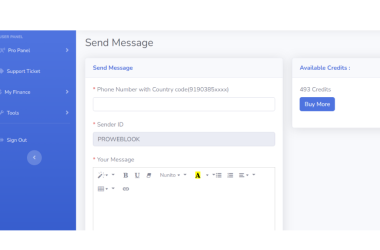Introduction.
DNS Lookup Tool: In the vast expanse of the internet, where billions of devices connect to countless websites and services, the Domain Name System (DNS) serves as the backbone of connectivity. At its core, DNS is a distributed database system that translates human-readable domain names into machine-readable IP addresses, enabling seamless communication across the web. In this comprehensive exploration, we delve into the intricacies of DNS lookup, unraveling its significance, mechanics, and practical applications.
Chapter 1: Understanding DNS Fundamentals.
To comprehend DNS lookup Tool fully, it’s essential to grasp the fundamental principles of the Domain Name System. This hierarchical structure consists of various levels, including:
1. Root Domain: At the top of the hierarchy are the root DNS servers, which manage the distribution of DNS queries across the internet.
2. Top-Level Domains (TLDs): Below the root domain are TLDs such as .com, .org, .net, and country-code TLDs (ccTLDs) like .us, .uk, and .jp.
3. Second-Level Domains: Situated beneath the TLDs are second-level domains, such as example.com, google.com, and wikipedia.org.
4. Subdomains: Subdomains are subdivisions of second-level domains, allowing for further categorization and organization of web resources (e.g., www.example.com, blog.example.com).
Each domain in the DNS hierarchy is associated with one or more DNS records, which contain information about the domain’s IP addresses, mail servers, and other essential data.
Chapter 2: The Role of DNS Lookup Tool.
DNS lookup is the process by which a device translates a domain name into its corresponding IP address. This process involves several steps:
1. Local DNS Cache Lookup: The device checks its local DNS cache to determine if it has previously resolved the domain name.
2. Recursive DNS Query: If the domain name is not found in the local cache, the device sends a recursive DNS quer
3. Response Caching: Once the resolver obtains the IP address, it caches the information locally to expedite future DNS lookups for the same domain name.
Chapter 3: Types of DNS Records.
DNS records are essential components of the Domain Name System, providing various types of information associated with a domain name. Some of the most common DNS record types include:
1. A (Address) Record: Maps a domain name to an IPv4 address.
2. AAAA (IPv6 Address) Record: Maps a domain name to an IPv6 address.
3. CNAME (Canonical Name) Record: Alias of one domain name to another.
4. MX (Mail Exchange) Record: Specifies mail servers responsible for receiving email on behalf of the domain.
5. NS (Name Server) Record: Indicates the authoritative name servers for the domain.
6. TXT (Text) Record: Stores arbitrary text data, often used for verification or authentication purposes.
7. SOA (Start of Authority) Record: Provides essential information about the domain, such as the primary authoritative name server and administrative contact details.
Understanding the purpose and function of these DNS records is crucial for managing domain names and configuring DNS settings effectively.
Chapter 4: DNS Resolution Process.
The DNS resolution process involves multiple steps, each performed by different entities within the DNS infrastructure. Here’s an overview of the DNS resolution process:
1. DNS Query Initiation: When a user attempts to access a domain name, their device initiates a DNS query to resolve the domain name to an IP address.
2. Local DNS Cache Lookup: The device checks its local DNS cache to see if it has recently resolved the domain name. If the information is found in the cache, the device retrieves the IP address without querying external DNS servers.
3. Recursive DNS Query: If the domain name is not cached locally, the device sends a recursive DNS query to its configured DNS resolver. The resolver then begins the process of recursively querying other DNS servers to resolve the domain name.
4. Iterative DNS Query: During the recursive query process, the resolver communicates with authoritative DNS servers responsible for the requested domain. These servers provide information about the domain’s DNS records, enabling the resolver to ultimately obtain the IP address.
5. Caching and Response: Once the resolver obtains the IP address, it caches the information locally for future use and returns the IP address to the requesting device. Subsequent DNS queries for the same domain can be resolved more quickly due to the cached information.
Chapter 5: Common DNS Issues and Troubleshooting.
While DNS is a robust and efficient system, various issues can arise that affect internet connectivity and website accessibility. Some common DNS issues include:
1. DNS Misconfigurations: Incorrect DNS settings can lead to domain name resolution failures or misdirection.
2. DNS Cache Poisoning: Malicious entities may attempt to manipulate DNS caches to redirect users to fraudulent websites.
3. DNS DDoS Attacks: Distributed Denial of Service (DDoS) attacks targeting DNS infrastructure can disrupt internet services by overwhelming DNS servers with traffic.
4. DNS Propagation Delays: Changes to DNS records may take time to propagate across the internet, resulting in temporary inconsistencies in domain resolution.
Chapter 6: DNS Security Measures.
Maintaining the security and integrity of the Domain Name System is paramount for ensuring a safe and reliable internet experience. Several measures can enhance DNS security, including:
1. DNSSEC (Domain Name System Security Extensions): DNSSEC adds cryptographic signatures to DNS records, enabling DNS resolvers to verify the authenticity of DNS data and protect against DNS spoofing and tampering.
2. DNS Filtering: Implementing DNS filtering solutions can block access to malicious or undesirable websites, providing an additional layer of security for network users.
3. DDoS Mitigation: Deploying DDoS mitigation techniques, such as rate limiting and traffic filtering, can help mitigate the impact of DNS DDoS attacks and ensure the availability of DNS services.
4. DNS Monitoring and Logging: Regular monitoring and logging of DNS traffic can help detect suspicious activity and potential security threats, enabling prompt remediation actions.
Chapter 7: Emerging Trends and Future Outlook
1. DNS over HTTPS (DoH): DoH encrypts DNS queries and responses, enhancing privacy and security for users by preventing eavesdropping and tampering.
2. Zero Trust Networking: Zero Trust Networking frameworks advocate for a security model that distrusts all users and devices by default, relying on continuous authentication and authorization mechanisms, including DNS-based authentication.
3. Edge DNS: Edge DNS solutions leverage distributed edge computing infrastructure to bring DNS resolution closer to end-users, reducing latency and enhancing performance. B
4. DNS Firewalling: DNS firewalling solutions analyze DNS traffic in real-time to identify and block malicious domains, IP addresses, and DNS queries associated with cyber threats such as malware, phishing attacks.
5. DNS Analytics and Machine Learning: DNS analytics platforms leverage machine learning and artificial intelligence (AI) algorithms to identify potential security threats.
6. Decentralized DNS: Decentralized DNS initiatives aim to decentralize control and ownership of the DNS infrastructure by leveraging block chain technology and peer-to-peer (P2P) networks. However, widespread adoption of decentralized DNS solutions may face challenges related to scalability, interoperability, and governance.
In conclusion.
DNS lookup Tool is a critical component of the internet ecosystem, enabling the resolution of domain names to IP addresses . Organizations bolster cybersecurity with innovations like DNS over HTTPS, Zero Trust Networking, Edge DNS, DNS firewalling, analytics, and decentralized DNS.
Kindly check our website Proweblook for more Web API tools. More resources can be found on our Github page. Social Channels are Twitter, Facebook & Youtube.








